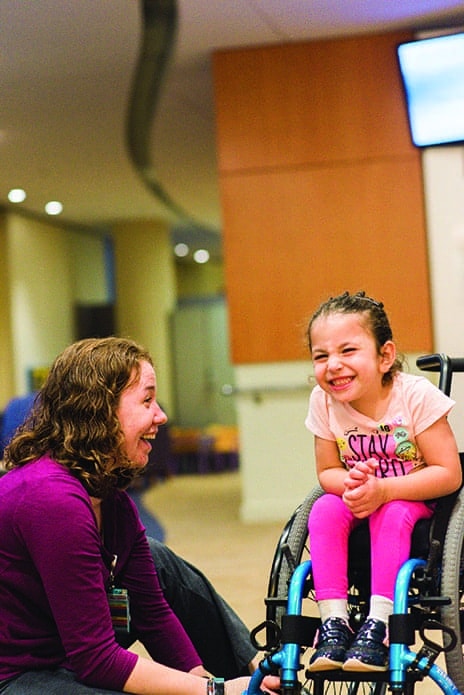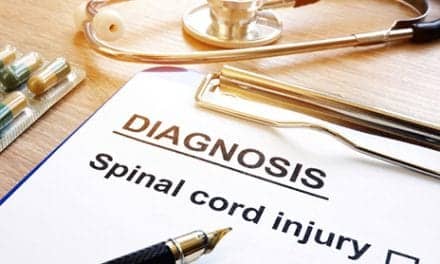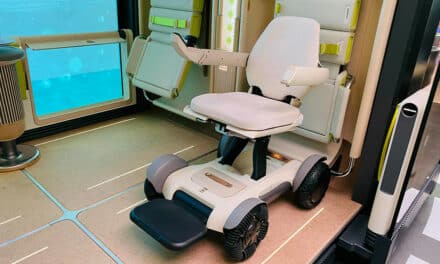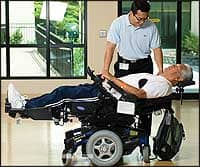
Pediatric equipment can be life-changing for a patient and family. Under ideal circumstances, the equipment should be delivered in a seating and mobility clinic with both the vendor and therapist present.
by Elizabeth Farrell, PT, DPT, PCS, ATP/SMS, and Kaitlin MacDonald, MOT, OTR/L
Rehabilitation goes far beyond the therapy clinic. Patients, families, and therapists work hard in the clinic to achieve the following goals: increase a child’s independence with mobility; achieve positioning that best meets the child’s medical and functional needs; and increase overall participation at home, school, and in the community. Specialized equipment is often required for the child to meet these goals. The equipment is most often recommended by the physical therapist or occupational therapist 76% of the time, although the prescribing physician, vendor, and patient’s family are also very involved in this process.1 The process of obtaining rehabilitation equipment can be long and cumbersome. In addition to evaluating the patient for each piece of equipment, a therapist must provide the necessary documentation to ensure funding for each piece of equipment and adequately train the patient and family on correct positioning and use of recommended equipment. Otherwise, the end result may be one that fills a therapist with dread: the patient does not use the equipment.
Reasons for Non-Use
There are many reasons for patient non-use of a previously prescribed piece of rehabilitation equipment. The most common reason is that the child has outgrown the piece of equipment. Child refusal to use the equipment and also lack of buy-in from the patient or family members are other reasons that prescribed equipment may be abandoned. Two other reasons for non-use reported in a survey of 108 patients are that the equipment did not fit in the home and that the patient and family were not educated on proper usage of the equipment.1 As medical professionals who work hard to get these items covered, it is our responsibility to identify potential reasons for non-use and adequately train the family about proper usage of this equipment. We must emphasize the medical and functional benefits of using each piece of equipment as prescribed.
Evaluating Need As a Whole Picture
The first step in obtaining a piece of rehab equipment is to perform a comprehensive evaluation. The evaluation considers this patient and family as a whole and includes the patient’s goals, home setup, transportation, and time available in the child’s day for utilizing the equipment. These factors may impact whether a piece of equipment can and will be utilized. The environment in which the family plans to utilize the equipment and their goals for each piece of equipment are key in determining the most appropriate equipment for the patient.
Pediatric Rehab Technologies
Common rehabilitation equipment prescribed for the home, school, and community include adaptive strollers, standing frames, gait trainers, and wheelchairs. An adaptive stroller is a device designed for a caregiver to dependently push a patient in a variety of environments. Positioning components can be added to an adaptive stroller to optimize the patient’s positioning in this device. A standing frame is a device that allows a patient to achieve and maintain a standing position if they lack the strength to stand independently. There are also a variety of positioning options that can be added to customize this device for a patient. A gait trainer is a device that provides support for an individual to stand and step independently when decreased strength or abnormal muscle tone prohibit them from stepping on their own. Finally, manual and power wheelchairs are pieces of complex rehabilitation technology that can be highly customized to improve positioning and provide a patient with an independent means of mobility.
All of these items can be tailored to meet the individual needs of the patient. The patient and caregivers must be trained to utilize the equipment properly in order to maximize the therapeutic benefit for the patient. It is important to reassess fit and continued need of equipment as the patient grows, especially during the transition from childhood to adolescence. The family must also be educated about signs that the child may be outgrowing each piece of equipment so that the existing equipment can be grown or larger equipment recommended.
Education Ties it All Together: Family, Supplier, Technology
It is imperative that the family receive education about positioning the child correctly in each piece of rehab equipment. Proper positioning and correct use of each piece of equipment will decrease secondary effects of physical disabilities such as orthopedic deformities or pressure sores. Once the family learns to position their child, educating the family about the device’s pressure-relieving mechanisms is imperative. This includes educating the family about pressure-relief methods, duration, and frequency. General guidelines for pressure relief in a seating system are for the patient to maintain approximately 35 degrees of tilt along with 100 degrees of recline for 2 minutes, every hour, or 1 minute every 30 minutes.2
After a patient gets out of the device, skin checks will be critical to ensure the fit continues to be appropriate. If redness does begin to occur, this could be a sign that the family needs to contact their vendor or clinician to assess current fit and positioning. The family should verbalize and demonstrate knowledge of adequate pressure reliefs both at the time of equipment evaluation and also upon delivery.
Once the patient is evaluated and equipment is prescribed and received, the vendor becomes the primary contact. The equipment supplier is responsible for repairing the device and modifying the equipment as needed to grow with the child. Prior to ordering the piece of equipment, the vendor and therapist should work together to build growth into the mobility equipment for pediatric patients. While the family may not need to know how to grow the device, they should be knowledgeable about whether the device has the capability for growth.
Under ideal circumstances, the equipment should be delivered in a seating and mobility clinic with both the vendor and therapist present. There is the potential that the equipment may be sized incorrectly upon delivery, or the family has waited so long for it that their education about the equipment needs to be refreshed. The patient may have also grown from the time that the equipment was ordered until delivery. As therapists, we need to educate the patient, family, and vendor about what should happen upon delivery of the equipment. If it is not possible for the delivery to occur in a clinical setting, with a therapist present, it is important to set the expectation with the family and vendor that the equipment must be trialed at home. The trial should be done with the patient while the vendor is present and available to fit or modify equipment as needed.
In advance of the prescription and delivery of rehab equipment, there should be ample patient and caregiver education including hands-on training with trial equipment to ensure safe and effective use of each device. It may be useful to have one family member educate other caregivers under a therapist’s guidance. This will demonstrate the level of understanding of each piece of equipment and possibly identify other training needs. Ideally, it will be best to send the family home with pictures and videos of proper setup and use of each piece of equipment. If the therapist is not present at delivery, this will give the family and the vendor a point of reference should questions arise.
Training and Transportation
Training on each piece of rehab equipment is not limited to basic setup and use. Training should also include information about transporting, maintaining, and cleaning the equipment. Pediatric strollers and wheelchairs often include a transit option, which allows for the child to be transported in the mobility device. However, transportation in a car seat is often considered a safer choice if the child can be easily transferred from the wheelchair or stroller into a car seat. If the child is being transported in the mobility device, the family should be educated about proper use of tie-downs and the vehicle’s lap and shoulder belt to maximize safety during transportation.
If the child has a ventilator, oxygen, or other medical equipment, this should be secured with a seat belt or propped with pillows to keep it in place during travel. If a child is traveling to/from school with a gait trainer or stander, it may be beneficial to investigate whether alternative equipment could be used at school or if the patient’s personal equipment could be kept at school (if not utilized at home) to minimize unnecessary travel. Equipment can easily be broken during travel, so it is worth making an inquiry to determine ways to minimize that travel time.
Regular cleaning and maintenance should be done to extend the life of rehab equipment, which typically needs to last at least 5 years. When using pediatric rehab equipment with children, food and dirt can easily build up. For all equipment, it is best to follow the manufacturer’s instructions for cleaning. Any maintenance beyond basic care and cleaning should be performed by the child’s rehab equipment supplier’s service department.
Life-Changing Results
Pediatric equipment can be life-changing for a patient and family. They can provide increased opportunities for mobility, cognitive development, medical benefits, and social benefits, which can increase the child’s participation at home, school, and the community. To ensure that the family can utilize their prescribed equipment, the therapist must make sure there is space in the home, accessibility, and that the equipment aligns with the family’s goals. RM
Elizabeth Farrell, PT, DPT, PCS, ATP/SMS, is a senior physical therapist at the International Center for Spinal Cord Injury at Kennedy Krieger Institute. She received her Doctor of Physical Therapy degree from the University of Maryland, Baltimore, in 2007, and has a graduate certificate in the Business of Health from the Johns Hopkins University Carey Business School. Her primary interests are in seating and positioning, and pediatric applications of ABRT.
Kaitlin MacDonald, MOT, OTR/L, is an occupational therapist and manager of therapy services at the International Center for Spinal Cord Injury at Kennedy Krieger Institute. She received her Master of Occupational Therapy degree from Saint Francis University, Loretto, Pa, in 2010. Her primary interests are in pediatric applications of ABRT and assistive technology. For more information, contact [email protected].
References
1. Peredo DE, Davis BE, Norvell DC, Kelly PC. Medical equipment use in children with disabilities: a descriptive survey. J Pediatr Rehabil Med. 2010;3(4):259-267
2. Liu HE, Cooper R, Kelleher A, Cooper RA. An interview study for developing a user guide for powered seating function usage. Disabil Rehabil Assist Technol. 2014;9(6):499–512.





